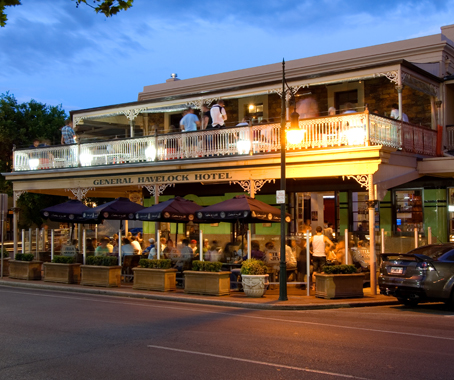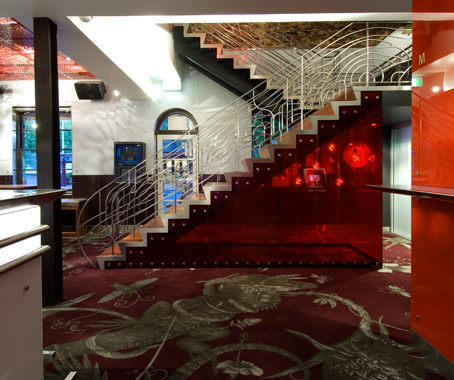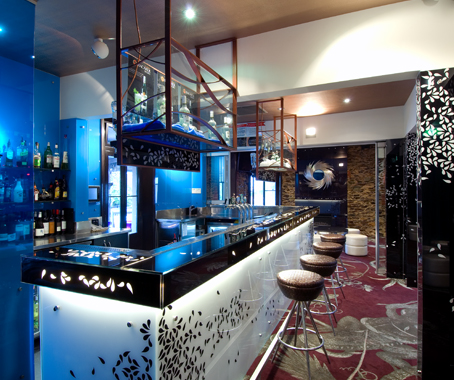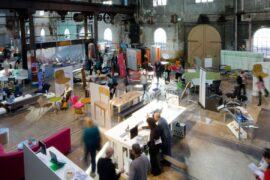Milne Architects delve into the General Havelock’s Art Deco history to create a new look that seamlessly blends classic and contemporary.
December 6th, 2010
Adelaide’s General Havelock hotel has stood on the corner of Hutt and Carrington streets since 1862. In need of a facelift, the heritage-listed building’s new design needed both to comply with State Heritage requirements and give the old local a contemporary spin.

Milne Architects didn’t need to look far for inspiration. “We uncovered façade cladding in jade green Vitrolite glass and a black terrazzo dado,” says Ken Milne, Principal of Milne Architects.
“These features had been concealed by years of paint and were a rewarding discovery.”
The theme for the building’s new interior became Art Deco with a modern twist, created in collaboration with Hellen from Prana Design Studios.
Viridian Seraphic glass in white and red dominates the main bar. A newly-installed atrium provides light to the space.
A back-lit aluminium ceiling panel sprinkles a dappled leaf pattern over the wall and columns.

The first floor continues the theme of the ground floor through its creative use of glass, but the feel is notably different.
A black and white bar with a ‘falling leaves’ pattern dominates the first floor, with the leaf motif repeated in the immediate surrounding area. The colour scheme is black, white, chocolate and cobalt blue.

“One of the most successful aspects of the design has been the transformation of the first floor, taking it from a ‘poor cousin’ to a standalone success,” explains Milne.
The new General Havelock has a coherent style that still leaves a lot to be discovered. As Milne notes, “there are lots of little delights throughout the hotel.”
Milne Architects
milnearchitects.com.au
Prana Design + Art Studios
pranastudios.com.au
INDESIGN is on instagram
Follow @indesignlive
A searchable and comprehensive guide for specifying leading products and their suppliers
Keep up to date with the latest and greatest from our industry BFF's!

In design, the concept of absence is particularly powerful – it’s the abundant potential of deliberate non-presence that amplifies the impact of what is. And it is this realm of sophisticated subtraction that Gaggenau’s Dishwasher 400 Series so generously – and quietly – occupies.

To honour Chef James Won’s appointment as Gaggenau’s first Malaysian Culinary Partner, we asked the gastronomic luminaire about parallels between Gaggenau’s ethos and his own practice, his multidimensional vision of Modern Malaysian – and how his early experiences of KFC’s accessible, bold flavours influenced his concept of fine dining.

In this candid interview, the culinary mastermind behind Singapore’s Nouri and Appetite talks about food as an act of human connection that transcends borders and accolades, the crucial role of technology in preserving its unifying power, and finding a kindred spirit in Gaggenau’s reverence for tradition and relentless pursuit of innovation.

Dance For Life (DFL) supports ReachOut, a platform for youth dealing with mental health issues. With current statistics stating that up to one in five Australians experience symptoms of mental illness, it is something that many in the design community, and the wider community, come into contact with.
The internet never sleeps! Here's the stuff you might have missed

Saturday Indesign is one of the standout fixtures on the Asia-Pacific design calendar – but how exactly did it start, and when did it become so big?

The fourth edition of the First Nations Writers Festival took place in May 2025, and we spoke to Baka Barakove Bina about the importance of place and home in his writing, as well as the things that make the Pacific region so distinctive.